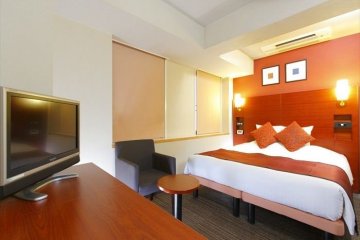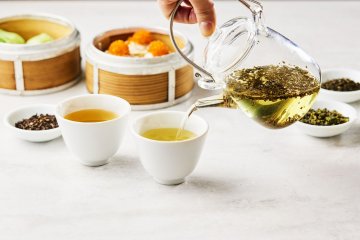
Admirez les Lotus de Yokohama
Larry KnipfingLe jardin Sankei-en de Yokohama abrite un somptueux étang de lotus. La beauté de ce parc est à son paroxysme entre mi-juillet et mi-août.

En 1859, lorsque le port de Yokohama s'est ouvert au commerce extérieur, la soie était la principale exportation du pays. En 1909, le Japon était le plus important fournisseur de soie au monde, desservant des marchés tels que les États-Unis d'Amérique et l'Europe.
Le jardin Sankeien a été construit par Tomitaro Hara, connu sous le pseudonyme Sankei Hara, un grand entrepreneur qui produisait et vendait de la soie à Yokohama. Au début des années 1900, il a utilisé une partie de sa richesse pour créer des jardins japonais pendant environ 20 ans.
Le jardin Sankeien s'étend sur environ 175 000 mètres carrés et s'étend sur trois vallées le long de la côte. Il se compose d'un jardin extérieur ouvert au public depuis 1906 et d'un jardin intérieur qui était à l'origine gardé privé pour l'usage personnel de Sankei.
Dix-sept structures historiques qui ont été déplacées de Kyoto, Kamakura et d'autres endroits ont été mises en harmonie avec la nature au cours des quatre saisons pour créer de superbes paysages.

Le jardin Sankei-en de Yokohama abrite un somptueux étang de lotus. La beauté de ce parc est à son paroxysme entre mi-juillet et mi-août.

L'hôtel MyStays Yokohama, la localisation parfaite pour explorer le bord de mer.

Idéal pour les couples ou les groupes (jusqu'à 12 personnes), Masago propose une cuisine kaiseki savoureuse, délicieuse et artistique. Essayez leur cuisine classique de style japonais qui a été modifiée pour un goût plus international tout en conservant l'harmonie de ses saveurs originales.

Le Peace Cafe propose un menu végétalien délicieux et coloré. Vous ne serez pas déçu par le café d'inspiration hawaïenne où vous pourrez goûter la salade de tacos mexicaine, le tofu-katsu et le curry avec une ration supplémentaire de légumes.

Profitez d'un après-midi de thé chinois avec dim sum, shumai et boulettes de pâte à MS. CASABLANCA. Cet espace de restauration chinois décontracté est chic et confortable, offrant une cuisine chinoise haut de gamme à Kanagawa.

Known in Japanese as ‘Negishi Shinrin Koen’, this is one of the largest parks in Yokohama with a surface area covering over 1800 square meters. Originally built as a racing track in 1867, it was home to the first western style horse racing in Japan. However, after the Second World War it was redeveloped into a golf course by occupation forces. Its fortunes were changed once again in 1977 when it was officially opened by Yokohama city as Negishi Forest Park.

Masobyo Temple (媽祖廟), also called Ma Zhu Miao, is located in Yokohama’s Chinatown. The young Taoist temple, which opened relatively recently in 2006, enshrines Mazu, the Chinese Goddess of the Sea. Despite its young age, the temple exudes ancient spirituality older than its years. The structure has a geometrical base and is decorated with blue, green, red, and gold detailing. A massive gate welcomes visitors and worshippers alike and is connected to the main temple with a line of red lanterns. Inside Masobyo, a statue of Mazu is cloaked in vibrant attire and wearing an imperial headdress, symbolizing her godly status. The interior is equally as impressive as the outside with exquisite designs covering every surface. Worshippers commonly go to the temple to pray for safe travels since, historically, sailors and fishermen would pray to the goddess for calm seas during their journeys. History of Mazu: Goddess of the Sea As a human, Mazu was born in the tenth century and named Lin Mo. According to legend, she was gifted with supernatural abilities, such as predicting the weather, calming storms, and experiencing visions. She dedicated her life to the teachings of Tao and ascended to the heavens at age 28 as a goddess. Mazu has two demon bodyguards, Qianliyan and Shunfenger. Both demons vowed to protect Mazu after failing to defeat her in combat for her hand in marriage. Inside Masobyo, statues of the demon guardians stand to the left and right of Mazu. One, colored red, is positioned in a listening pose with his hand to his ear, while the green colored one is diligently watching, with eyes that seem to scan the temple. Today Worshippers visit Masobyo to pray to Mazu for safe travels, as well as general health and safety. The temple is also a popular spot for tourists due to its traditional architecture and cultural significance in Chinatown. Of course, Mazu’s affinity for keeping travellers safe is appealing to tourists as well. Masobyo’s temple staff are extremely helpful and more than willing to teach visitors the appropriate methods of worship. Individuals who want a closer look at Mazu’s statue are required to buy incense sticks, which they place in five burners. After lighting the incense sticks, they should bow in respect. During New Years, the temple becomes crowded with people participating and watching the festive displays.

Le quartier chinois de Yokohama (Yokohama Chinatown), également connu sous le nom de Yokohama Chukagai, est le plus grand quartier chinois du Japon avec plus de 250 restaurants et boutiques, dans la métropole de Yokohama au sud de Tokyo. Lorsque la ville portuaire a été ouverte au commerce international en 1859, de nombreux immigrants chinois sont arrivés à Yokohama, mais n’étaient initialement pas été autorisés à quitter la zone qui leur était assignée en raison des réglementations du gouvernement de l'époque. C’est pourquoi on peut littéralement dire que Yokohama Chukagai est le quartier chinois de la ville. Avec la construction des quatre portes d'entrée, Chinatown a été officiellement reconnu en 1955 et est depuis l'une des attractions principales de la ville. Ce sont surtout la cuisine chinoise et les nombreux souvenirs qui font de Yokohama Chinatown une destination touristique populaire, en particulier pour célébrer le nouvel an chinois.